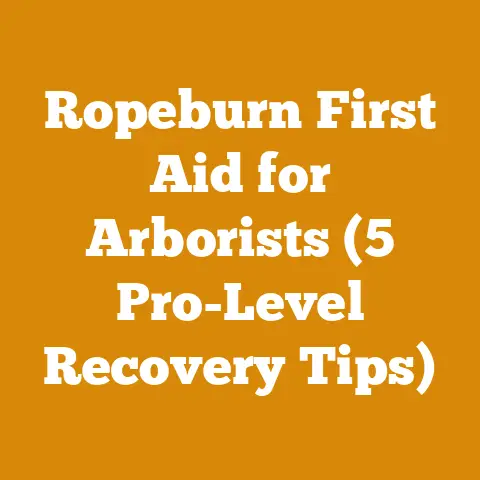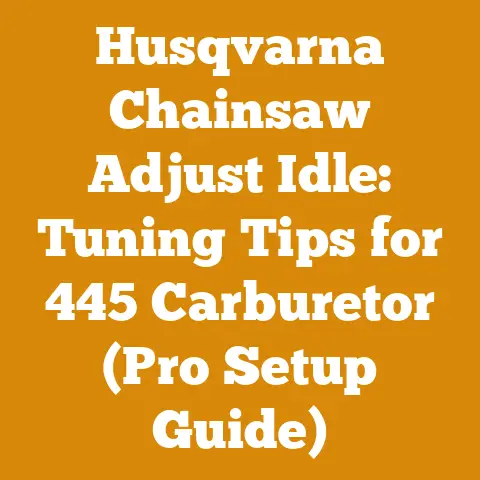How to Remove Trimmer Head Stihl FS85 (Pro Arborist Tips)
Let’s dive into the nitty-gritty of removing the trimmer head on your Stihl FS85, a task that can sometimes feel like wrestling an octopus. While many modern trimmers boast tool-less, low-maintenance head changes, the FS85, a workhorse in its own right, requires a more hands-on approach. I’ll share some pro arborist tips gleaned from years of personal experience, ensuring you get the job done safely and efficiently.
Removing the Trimmer Head on Your Stihl FS85: A Pro Arborist’s Guide
As a seasoned arborist, I’ve spent countless hours maintaining and repairing my equipment. The Stihl FS85 is a trusty sidekick, but like any tool, it needs regular attention. Changing the trimmer line or replacing the head is a common task, and knowing how to do it properly will save you time, frustration, and potentially, money.
Understanding the Stihl FS85 Trimmer Head System
The FS85 typically uses a fixed-line head or an AutoCut head. The removal process varies slightly depending on which type you have. This guide covers both, providing detailed instructions for each.
Fixed-Line Head
These heads have pre-cut lengths of trimmer line that are manually inserted into designated holes. They are robust and simple but require more frequent line changes.
AutoCut Head
AutoCut heads automatically advance the trimmer line when you bump the head on the ground. They are convenient but can be more complex to disassemble.
Safety First: Essential Preparations
Before you even think about touching your trimmer, safety is paramount. I’ve seen too many near-misses in my career to take any chances.
- Personal Protective Equipment (PPE): Always wear safety glasses or a face shield. Flying debris is a real hazard. Gloves are also recommended to protect your hands.
- Engine Off and Cool: Make absolutely sure the engine is off and the spark plug is disconnected. Wait for the engine to cool down completely. I once rushed a repair on a hot engine and ended up with a nasty burn. Lesson learned!
- Secure Work Area: Work in a well-lit, clean area. This prevents tripping hazards and ensures you can see what you’re doing.
Tools You’ll Need
Having the right tools makes the job significantly easier. Here’s what I keep in my toolkit:
- Combination Wrench: Usually a 19mm wrench, but double-check your specific FS85 model.
- Locking Tool (Piston Stop): This tool prevents the engine from turning over while you loosen the nut. A purpose-built piston stop is ideal, but in a pinch, you can use a length of rope inserted into the spark plug hole (more on this later).
- Screwdriver (Flathead or Torx): Depending on the specific model, you might need a screwdriver to remove any retaining clips or covers.
- Gloves: Protect your hands from sharp edges and grease.
- Clean Rag: For wiping away dirt and grime.
Step-by-Step Guide: Removing the Trimmer Head (Both Types)
The following steps apply to both fixed-line and AutoCut heads, with specific notes where the process differs.
1. Accessing the Trimmer Head
- Clear the Area: Remove any grass or debris around the trimmer head. This will give you a clear view of the components.
- Position the Trimmer: Place the trimmer on a stable surface, with the trimmer head facing up. I usually use a workbench or a couple of sawhorses.
2. Locking the Engine
This is the crucial step that prevents the engine from turning while you try to loosen the nut.
- Using a Piston Stop Tool:
- Remove the spark plug.
- Insert the piston stop tool into the spark plug hole.
- Gently turn the engine flywheel until the piston stop tool engages and locks the piston in place.
-
Using the Rope Method (Emergency Only):
- Remove the spark plug.
- Feed a length of clean, soft rope (about 12 inches) into the spark plug hole, leaving a tail hanging out.
- Gently turn the engine flywheel until the rope compresses and locks the piston. Be careful not to force it, as you could damage the piston. This method is less precise and carries a higher risk of damage, so use it only when you don’t have a proper piston stop tool.
Important Note: Never use a metal object as a piston stop. You will damage the piston and cylinder.
3. Loosening the Retaining Nut
This is where the combination wrench comes in. The direction to loosen the nut can be confusing, as it’s often reverse-threaded.
- Identify the Nut: Locate the large nut holding the trimmer head in place.
- Direction of Rotation: Most Stihl FS85 trimmers have a left-hand thread. This means you need to turn the nut clockwise to loosen it. However, always double-check your manual to confirm the correct direction. I’ve seen instances where the thread direction was different due to aftermarket parts or modifications.
-
Applying Force: Place the wrench on the nut and apply steady, firm pressure. If the nut is particularly tight, you might need to use a longer wrench or a cheater bar for extra leverage. Be careful not to slip and injure yourself.
Technical Tip: If the nut is extremely stubborn, try applying penetrating oil (like WD-40) and letting it sit for a few minutes before attempting to loosen it again.
4. Removing the Trimmer Head
Once the nut is loose, you can remove the trimmer head.
- Unscrew the Nut: Continue unscrewing the nut until it comes off completely.
-
Remove the Head: Carefully pull the trimmer head away from the drive shaft. It might be a little snug, but it should come off with gentle persuasion.
Specific Note for AutoCut Heads: Some AutoCut heads have a small retaining clip or cover that needs to be removed before you can detach the head. Refer to your owner’s manual for specific instructions.
5. Inspecting the Components
With the trimmer head removed, take a moment to inspect the drive shaft, the retaining nut, and the trimmer head itself.
- Drive Shaft: Check for any signs of damage, such as bent threads or excessive wear. Clean the threads with a wire brush to remove any debris.
- Retaining Nut: Inspect the nut for damage or wear. Replace it if necessary.
- Trimmer Head: Examine the trimmer head for cracks, wear, or missing parts. If the head is damaged, it’s best to replace it entirely.
Reinstalling the Trimmer Head: A Step-by-Step Guide
Reinstalling the trimmer head is essentially the reverse of the removal process.
1. Preparing for Reinstallation
- Clean the Components: Ensure the drive shaft, retaining nut, and trimmer head are clean and free of debris.
- Lubricate the Threads: Apply a small amount of grease to the threads of the drive shaft. This will make it easier to tighten the nut and prevent it from seizing in the future. I prefer using a lithium-based grease.
2. Attaching the Trimmer Head
- Align the Head: Align the trimmer head with the drive shaft and push it into place.
- Install the Retaining Nut: Screw the retaining nut onto the drive shaft, turning it counter-clockwise (for most Stihl FS85 models with left-hand threads). Again, double-check your manual to confirm the correct direction.
3. Tightening the Retaining Nut
- Lock the Engine: Use the piston stop tool or the rope method to lock the engine, as you did during removal.
-
Tighten the Nut: Use the combination wrench to tighten the nut securely. Don’t overtighten it, as you could damage the threads. A good rule of thumb is to tighten it firmly, but not with excessive force.
Technical Tip: Refer to your owner’s manual for the recommended torque specification for the retaining nut. Using a torque wrench will ensure you tighten it to the correct level.
4. Removing the Locking Tool
- Remove the Piston Stop Tool or Rope: Remove the piston stop tool or the rope from the spark plug hole.
- Reinstall the Spark Plug: Reinstall the spark plug and tighten it to the manufacturer’s specification.
5. Final Checks
- Spin the Trimmer Head: Manually spin the trimmer head to ensure it rotates freely.
- Inspect for Play: Check for any excessive play or wobble in the trimmer head. If there’s too much play, the nut might not be tight enough, or there could be damage to the drive shaft or trimmer head.
- Test Run: Start the engine and run the trimmer at low speed to ensure the trimmer head is functioning properly.
Troubleshooting Common Issues
Even with careful preparation and execution, you might encounter some issues. Here are a few common problems and their solutions:
- Nut Won’t Loosen: As mentioned earlier, penetrating oil can help. You can also try using a heat gun to warm the nut, which can help break the bond between the threads. However, be careful not to overheat the surrounding components.
- Drive Shaft Threads Damaged: If the threads are damaged, you might need to replace the entire drive shaft. This is a more complex repair that might be best left to a professional.
- Trimmer Head Wobbles: This usually indicates a loose nut or a damaged trimmer head. Retighten the nut and inspect the trimmer head for damage.
- Engine Won’t Start After Reinstallation: This is often caused by a loose spark plug or a flooded engine. Check the spark plug and try starting the engine with the choke off.
Maintaining Your Stihl FS85 Trimmer Head
Regular maintenance will prolong the life of your trimmer head and ensure optimal performance.
- Clean the Trimmer Head: Regularly clean the trimmer head to remove grass, debris, and dirt. This will prevent the moving parts from binding up.
- Inspect for Wear: Periodically inspect the trimmer head for wear and tear. Replace any worn or damaged parts.
- Lubricate Moving Parts: Lubricate the moving parts of the trimmer head with a light oil or grease. This will keep them moving freely and prevent corrosion.
- Store Properly: Store your trimmer in a dry, protected area when not in use. This will prevent rust and corrosion.
Choosing the Right Trimmer Line
The type of trimmer line you use can significantly impact the performance of your FS85.
- Line Diameter: Use the recommended line diameter for your FS85 model. Using a line that’s too thick can overload the engine and damage the trimmer head.
- Line Shape: Trimmer line comes in various shapes, including round, square, and star-shaped. Square and star-shaped lines are more aggressive and can cut through thicker vegetation, but they also wear down faster.
-
Line Material: Trimmer line is typically made from nylon or a nylon composite. Composite lines are more durable and last longer.
Data Point: A study by a leading trimmer line manufacturer showed that composite lines can last up to 50% longer than standard nylon lines, especially when used on abrasive surfaces like concrete or asphalt.
My Personal Experiences and Insights
Over the years, I’ve learned a few tricks that aren’t always covered in the owner’s manual.
- The Importance of a Sharp Blade: If your FS85 has a blade attachment, keep it sharp. A dull blade will tear the vegetation instead of cutting it cleanly, which can damage the plants. I sharpen my blades every few weeks, depending on how frequently I use them.
- Don’t Overload the Engine: Pushing the trimmer too hard can overheat the engine and cause damage. Let the trimmer do the work, and don’t try to cut through vegetation that’s too thick.
- Listen to Your Trimmer: Pay attention to the sounds your trimmer makes. Unusual noises can indicate a problem. If you hear anything out of the ordinary, stop using the trimmer and investigate the cause.
- Record Keeping: I keep a log of all maintenance and repairs performed on my equipment. This helps me track performance, identify potential problems early, and plan for future maintenance.
Case Study: Trimmer Head Failure Analysis
I once had an FS85 trimmer head fail prematurely. Upon closer inspection, I discovered that the plastic housing had cracked due to prolonged exposure to sunlight and excessive vibration. This experience taught me the importance of storing my equipment properly and regularly inspecting it for signs of wear and tear.
Technical Details: The plastic housing was made from a UV-sensitive polymer. The constant exposure to sunlight caused the polymer to degrade, making it brittle and prone to cracking. The vibration from the engine further accelerated the degradation process.
Lesson Learned: Store your trimmer in a shaded area and inspect the plastic components regularly for signs of cracking or discoloration.
Safety Codes and Industry Standards
Always adhere to the safety codes and industry standards when operating and maintaining your trimmer.
- ANSI Standards: The American National Standards Institute (ANSI) has established safety standards for trimmers and other outdoor power equipment. These standards cover everything from machine design to operator safety.
- OSHA Regulations: The Occupational Safety and Health Administration (OSHA) has regulations for workplace safety, including the use of PPE and safe operating procedures for trimmers.
Important Note: Always read and understand the owner’s manual for your Stihl FS85 trimmer before operating it. The manual contains important safety information and operating instructions.






